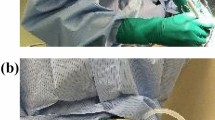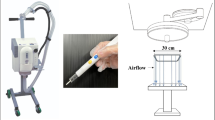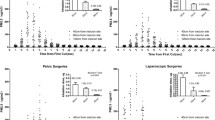Abstract
“Surgical smoke” is an airborne by-product of electrosurgery comprised of vapour and suspended particles. Although concerns exist that exposure may be harmful, there is a poor understanding of the smoke in terms of particle size, morphology, composition and biological viability. Notably, it is not known how the biological tissue source and cutting method influence the smoke. The objective of this study was to develop a collection method for airborne by-product from surgical cutting. This would enable comprehensive analyses of the particulate burden, composition and biological viability. The method was applied to compare the electrosurgical smoke generated (in the absence of any evacuation mechanism) with the aerosolized/airborne by-products generated by ultrasonic and high-speed cutting, from bone and liver tissue cutting. We report a wide range of particle sizes (0.93–806.31 μm for bone, 0.05–1040.43 μm for liver) with 50% of the particles being <2.72 μm (~PM2.5) and 90% being <10 μm (PM10). EDX and biochemical analysis reveal components of biological cells and cellular metabolic activity in particulate from liver tissue cut by electrosurgery and ultrasonic cutting. We show for the first time however that bone saws and ultrasonic cutting do not liberate viable cells from bone.







Similar content being viewed by others
References
Al Sahaf, O. S., I. Vega-Carrascal, F. O. Cunningham, J. P. McGrath, and F. J. Bloomfield. Chemical composition of smoke produced by high-frequency electrosurgery. Ir. J. Med. Sci. 176:229–232, 2007.
Alkatout, I., T. Schollmeyer, N. A. Hawaldar, N. Sharma, and L. Mettler. Principles and safety measures of electrosurgery in laparoscopy. JSLS 16:130–139, 2012.
Amaral, S. S., J. A. de Carvalho, M. A. M. Costa, and C. Pinheiro. An overview of particulate matter measurement instruments. Atmosphere (Basel). 6:1327–1345, 2015.
Andréasson, S. N., H. Anundi, B. Sahlberg, C.-G. Ericsson, R. Wålinder, G. Enlund, L. Påhlman, and H. Mahteme. Peritonectomy with high voltage electrocautery generates higher levels of ultrafine smoke particles. Eur. J. Surg. Oncol. 35:780–784, 2009.
Baggish, M. S., P. Baltoyannis, and E. Sze. Protection of the rat lung from the harmful effects of laser smoke. Lasers Surg. Med. 8:248–253, 1988.
Baggish, M. S., and M. Elbakry. The effects of laser smoke on the lungs of rats. Am. J. Obstet. Gynecol. 156:1260–1265, 1987.
Benias, P. C., and D. L. Carr-Locke. Principles of electrosurgery. Ercp 86–92:e1, 2019. https://doi.org/10.1016/b978-0-323-48109-0.00011-0.
Bonczyk, P. A., and J. J. Sangiovanni. Optical and probe measurements of soot in a burning fuel droplet stream. Combust. Sci. Technol. 36:135–147, 1984.
Brüske-Hohlfeld, I., G. Preissler, K.-W. Jauch, M. Pitz, D. Nowak, A. Peters, and H.-E. Wichmann. Surgical smoke and ultrafine particles. J. Occup. Med. Toxicol. 3:31, 2008.
Cascella, M., M. Rajnik, C. Arturo, D. S. C., and D. N. Raffaela. (2020) Features, Evaluation and Treatment Coronavirus (COVID-19). StatPearls Publishing, 2020. https://www.ncbi.nlm.nih.gov/books/NBK554776/?report=classic
Cavina, E., O. Goletti, N. Molea, P. Buccianti, M. Chiarugi, G. Boni, E. Lazzeri, and R. Bianchi. Trocar site tumor recurrences. May pneumoperitoneum be responsible? Surg. Endosc. 12:1294–1296, 1998.
ConMed. (2015) Operator’s Manual—System 5000 Electrosurgical Unit (60-8005-SYS). 2015. http://eifu.conmed.com/
DesCôteaux, J.-G., P. Picard, É. C. Poulin, and M. Baril. Preliminary study of electrocautery smoke particles produced in vitro and during laparoscopic procedures. Surg. Endosc. 10:152–158, 1996.
Dobrogowski, M., W. Wesołowski, M. Kucharska, A. Sapota, and L. S. Pomorski. Chemical composition of surgical smoke formed in the abdominal cavity during laparoscopic cholecystectomy—assessment of the risk to the patient. Int. J. Occup. Med. Environ. Health 27:314–325, 2014.
Dolan, E. B., M. G. Haugh, D. Tallon, C. Casey, and L. M. McNamara. Heat-shock-induced cellular responses to temperature elevations occurring during orthopaedic cutting. J. R. Soc. Interface 9:3503–3513, 2012.
Dolan, E. B., M. G. Haugh, M. C. Voisin, D. Tallon, and L. M. McNamara. Thermally induced osteocyte damage initiates a remodelling signaling cascade. PLoS ONE 10:1–17, 2015.
Dolan, E. B., T. J. Vaughan, G. L. Niebur, C. Casey, D. Tallon, and L. M. McNamara. How bone tissue and cells experience elevated temperatures during orthopaedic cutting: an experimental and computational investigation. J. Biomech. Eng. 136:021019, 2014.
Eder, C., A. Chavanne, J. Meissner, W. Bretschneider, A. Tuschel, P. Becker, and M. Ogon. Autografts for spinal fusion: osteogenic potential of laminectomy bone chips and bone shavings collected via high speed drill. Eur. Spine J. 20:1791–1795, 2011.
Edwards, B. E., and R. E. Reiman. Results of a survey on current surgical smoke control practices. AORN J. 87:739–749, 2008.
Edwards, B. E., and R. E. Reiman. Comparison of current and past surgical smoke control practices. AORN J. 95:337–350, 2012.
Elmashae, Y., R. H. Koehler, M. Yermakov, T. Reponen, and S. A. Grinshpun. Surgical smoke simulation study: physical characterization and respiratory protection. Aerosol Sci. Technol. 52:38–45, 2018.
Farrugia, M., S. Y. Hussain, and D. Perrett. Particulate matter generated during monopolar and bipolar hysteroscopic human uterine tissue vaporization. J. Minim. Invasive Gynecol. 16:458–464, 2009.
Fitzgerald, J. E. F., M. Malik, and I. Ahmed. A single-blind controlled study of electrocautery and ultrasonic scalpel smoke plumes in laparoscopic surgery. Surg. Endosc. Other Interv. Tech. 26:337–342, 2012.
Fletcher, J. N., D. Mew, and J.-G. DesCôteaux. Dissemination of melanoma cells within electrocautery plume. Am. J. Surg. 178:57–59, 1999.
Gao, S., R. H. Koehler, M. Yermakov, and S. A. Grinshpun. Performance of facepiece respirators and surgical masks against surgical smoke: simulated workplace protection factor study. Ann. Occup. Hyg. 60:608–618, 2016.
Garden, J. M. Papillomavirus in the vapor of carbon dioxide laser-treated verrucae. JAMA J. Am. Med. Assoc. 259:1199, 1988.
Garden, J. M., M. K. O’Banion, A. D. Bakus, and C. Olson. Viral disease transmitted by laser-generated plume (aerosol). Arch. Dermatol. 138:1303–1307, 2002.
Garden, J. M., M. K. O’Banion, L. S. Shelnitz, K. S. Pinski, A. D. Bakus, M. E. Reichmann, and J. P. Sundberg. Papillomavirus in the vapor of carbon dioxide laser-treated verrucae. JAMA 259:1199–1202, 1988.
Gatti, J. E., C. J. Bryant, R. B. Noone, and J. B. Murphy. The mutagenicity of electrocautery smoke. Plast. Reconstr. Surg. 89:781–784, 1992; (discussion 785-6).
Hallmo, P., and O. Naess. Laryngeal papillomatosis with human papillomavirus DNA contracted by a laser surgeon. Eur. Arch. OtorhinoLaryngol 248:425–427, 1991.
Hensman, C., D. Baty, R. G. Willis, and A. Cuschieri. Chemical composition of smoke produced by high-frequency electrosurgery in a closed gaseous environment. Surg. Endosc. 12:1017–1019, 1998.
In, S. M., D.-Y. Park, I. K. Sohn, C.-H. Kim, H. L. Lim, S.-A. Hong, D. Y. Jung, S.-Y. Jeong, J. H. Han, and H. J. Kim. Experimental study of the potential hazards of surgical smoke from powered instruments. Br. J. Surg. 102:1581–1586, 2015.
Infection prevention and control during health care for probable or confirmed cases of novel coronavirus (nCoV) infection. World Health Organization, 2013. https://www.who.int/csr/disease/coronavirus_infections/IPCnCoVguidance_06May13.pdf
Johnson, G. K., and W. S. Robinson. Human immunodeficiency virus-1 (HIV-1) in the vapors of surgical power instruments. J. Med. Virol. 33:47–50, 1991.
Karjalainen, M., A. Kontunen, S. Saari, T. Rönkkö, J. Lekkala, A. Roine, and N. Oksala. The characterization of surgical smoke from various tissues and its implications for occupational safety. PLoS ONE 13:e0195274, 2018.
Kasten, F. Falling speed of aerosol particles. J. Appl. Meteorol. 7:944–947, 1968.
Katz, J. The Electrostatic Precipitator: Application and Concepts. Handb. Powder Sci. Technol. 753–770, 1997. https://doi.org/10.1007/978-1-4615-6373-0_16
Khaled, U., and A. Z. Eldein. Experimental study of V-I characteristics of wire–plate electrostatic precipitators under clean air conditions. J. Electrostat. 71:228–234, 2013.
Krones, C. J., J. Conze, F. Hoelzl, M. Stumpf, U. Klinge, M. Möller, W. Dott, V. Schumpelick, and J. Hollender. Chemical composition of surgical smoke produced by electrocautery, harmonic scalpel and argon beaming—a short study. Eur. Surg. Acta Chir. Austriaca 39:118–121, 2007.
Kulkarni, P., P. A. Baron, and K. Willeke. Aerosol measurement: principles, techniques, and applications. Hoboken, NJ: Wiley, 2011.
Kuttenberger, J., E. Polska, and B. M. Schaefer. A novel three-dimensional bone chip organ culture. Clin. Oral Invest. 17:1547–1555, 2013.
Lee, S. J., and K. H. Park. Ultrasonic energy in endoscopic surgery. Yonsei Med. J. 40:545, 1999.
Lee, T., J.-C. Soo, R. F. LeBouf, D. Burns, D. Schwegler-Berry, M. Kashon, J. Bowers, and M. Harper. Surgical smoke control with local exhaust ventilation: experimental study. J. Occup. Environ. Hyg. 15:341–350, 2018.
Loh, S. A., G. A. Carlson, E. I. Chang, E. Huang, D. Palanker, and G. C. Gurtner. Comparative healing of surgical incisions created by the peak plasmablade, conventional electrosurgery, and a scalpel. Plast. Reconstr. Surg. 124:1849–1859, 2009.
Massarweh, N. N., N. Cosgriff, and D. P. Slakey. Electrosurgery: history, principles, and current and future uses. J. Am. Coll. Surg. 202:520–530, 2006.
McQuail, P. M., B. S. McCartney, J. F. Baker, and P. Kenny. Diathermy awareness among surgeons—an analysis in Ireland. Ann. Med. Surg. 12:54–59, 2016.
Medical Face Masks—Requirements and Test Methods Standard (BS EN 14683:2019)
Mick, P. T., and R. Murphy. Aerosol-generating otolaryngology procedures and the need for enhanced PPE during the COVID-19 pandemic: a literature review. J. Otolaryngol. Head Neck Surg. 49:1–10, 2020.
Nduka, C. C., N. Poland, M. Kennedy, J. Dye, and A. Darzi. Does the ultrasonically activated scalpel release viable airborne cancer cells? Surg. Endosc. 12:1031–1034, 1998.
Nezhat, C., W. K. Winer, F. Nezhat, C. Nezhat, D. Forrest, and W. G. Reeves. Smoke from laser surgery: Is there a health hazard? Lasers Surg. Med. 7:376–382, 1987.
Nikas, K. S. P., A. A. Varonos, and G. C. Bergeles. Numerical simulation of the flow and the collection mechanisms inside a laboratory scale electrostatic precipitator. J. Electrostat. 63:423–443, 2005.
Redmayne, A. C., D. Wake, R. C. Brown, and B. Crook. Measurement of the degree of protection afforded by respiratory protective equipment against microbiological aerosols. Ann. Occup. Hyg. 41:636–640, 1997.
Romano, F., J. Gustén, S. De Antonellis, and C. M. Joppolo. Electrosurgical smoke: ultrafine particle measurements and work environment quality in different operating theatres. Int. J. Environ. Res. Public Health 2017. https://doi.org/10.3390/ijerph14020137.
Roth, A. A., P. C. Tang, M. J. Ye, K. S. Mohammad, and R. F. Nelson. Improved autologous cortical bone harvest and viability with 2Flute otologic burs. Laryngoscope 128:E40–E46, 2018.
Schulz, H., V. Harder, A. Ibald-Mulli, A. Khandoga, W. Koenig, F. Krombach, R. Radykewicz, A. Stampfl, B. Thorand, and A. Peters. Cardiovascular effects of fine and ultrafine particles. J. Aerosol Med. 18:1–22, 2005.
Seipp, H.-M., T. Steffens, J. Weigold, A. Lahmer, A. Maier-Hasselmann, T. Herzog, and J. Herzog-Niescery. Efficiencies and noise levels of portable surgical smoke evacuation systems. J. Occup. Environ. Hyg. 0:1–20, 2018.
Sisler, J. D., J. Shaffer, J.-C. Soo, R. F. LeBouf, M. Harper, Y. Qian, and T. Lee. In vitro toxicological evaluation of surgical smoke from human tissue. J. Occup. Med. Toxicol. 13:12, 2018.
Song, C., B. Tang, P. A. Campbell, and A. Cuschieri. Thermal spread and heat absorbance differences between open and laparoscopic surgeries during energized dissections by electrosurgical instruments. Surg. Endosc. 23:2480–2487, 2009.
Steege, A. L., J. M. Boiano, and M. H. Sweeney. Secondhand smoke in the operating room? Precautionary practices lacking for surgical smoke. Am. J. Ind. Med. 59:1020–1031, 2016.
Sutton, P. A., S. Awad, A. C. Perkins, and D. N. Lobo. Comparison of lateral thermal spread using monopolar and bipolar diathermy, the Harmonic ScalpelTM and the LigasureTM. Br. J. Surg. 97:428–433, 2010.
The Cell: A Molecular Approach. 2nd edition. No Title. Sunderland (MA): Sinauer Associates, 2000. https://www.ncbi.nlm.nih.gov/books/NBK9839/
Tomita, Y., S. Mihashi, K. Nagata, S. Ueda, M. Fujiki, M. Hirano, and T. Hirohata. Mutagenicity of smoke condensates induced by CO2-laser irradiation and electrocauterization. Mutat. Res. Toxicol. 89:145–149, 1981.
Tseng, L. N., F. J. Berends, P. Wittich, N. D. Bouvy, R. L. Marquet, G. Kazemier, and H. J. Bonjer. Port-site metastases. Impact of local tissue trauma and gas leakage. Surg. Endosc. 12:1377–1380, 1998.
Ulmer, B. C. The hazards of surgical smoke. AORN J. 87:737–738, 2008.
Weld, K. J., S. Dryer, C. D. Ames, K. Cho, C. Hogan, M. Lee, P. Biswas, and J. Landman. Analysis of surgical smoke produced by various energy-based instruments and effect on laparoscopic visibility. J. Endourol. 21:347–351, 2007.
Workman, A. D., D. B. Welling, B. S. Carter, W. T. Curry, E. H. Holbrook, S. T. Gray, G. A. Scangas, and B. S. Bleier. Endonasal instrumentation and aerosolization risk in the era of COVID-19: simulation, literature review, and proposed mitigation strategies. Int. Forum Allergy Rhinol. 2020. https://doi.org/10.1002/alr.22577.
Zhao, L., and K. Adamiak. Numerical simulation of the electrohydrodynamic flow in a single wire-plate electrostatic precipitator. IEEE Trans. Ind. Appl. 44:683–691, 2008.
Acknowledgements
This work was supported by Science Foundation Ireland (SFI) and the European Regional Development Fund (Grant Number 13/RC/2073).
Author information
Authors and Affiliations
Corresponding author
Additional information
Associate Editor Umberto Morbiducci oversaw the review of this article.
Publisher's Note
Springer Nature remains neutral with regard to jurisdictional claims in published maps and institutional affiliations.
Rights and permissions
About this article
Cite this article
Casey, V.J., Martin, C., Curtin, P. et al. Comparison of Surgical Smoke Generated During Electrosurgery with Aerosolized Particulates from Ultrasonic and High-Speed Cutting. Ann Biomed Eng 49, 560–572 (2021). https://doi.org/10.1007/s10439-020-02587-w
Received:
Accepted:
Published:
Issue Date:
DOI: https://doi.org/10.1007/s10439-020-02587-w




